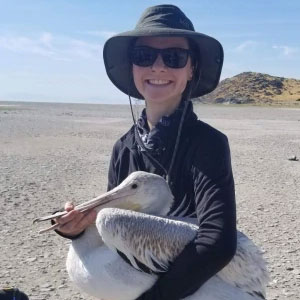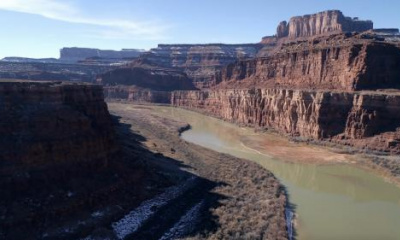Over 150 years ago, the United States Army attacked and killed as many as 500 Shoshone men, women and children in Northern Cache Valley. The attack resulted in one of the largest slaughters of Native Americans in U.S. history.
The site of the attack along the Bear River, referred to as “Boa Ogoi”, or more recently “Wuda Ogwa” by the Northwestern Shoshone, had been used for hundreds of years as a place for trade, cultural exchange and socialization by the Tribe. Rios Pacheco, Northwestern Shoshone spiritual leader, explained why the Shoshone used the site.
“The river helped them in their lives…the regular Bear River water, and then the hot springs, they all interacted with the Shoshone culture. And then all the plants, they were able to use them pretty much seasonal, and some were actually used year-round,” Pacheco said.
Wuda Ogwa, which translates directly to “Bear River,” was abandoned by the Shoshone after the massacre and eventually converted to agricultural fields. With agriculture came human impacts to the river and the land surrounding it.
In 2008, the Shoshone purchased part of the property in an effort to transform the site into a place of healing, both for people and for the land. Then, in 2018, as the Tribe was finalizing the purchase of an additional 600 acres, the former chairman of the Northwestern Shoshone Nation, Darren Parry, approached Utah State University with the hope of bringing culturally important species back to the site.
Parry’s move marked the beginning of an ambitious partnership between the Northwestern Shoshone, Utah State University researchers and local ecological consultants. Since 2018, the group has been collaborating on a plan to restore and preserve Wuda Ogwa far into the future. The goal is to return the land to what it was like before the pioneers arrived and to share Shoshone history with an interpretive center.
Darren Olsen, a biologist with ecological consulting firm Bio-West, explained the partnership’s goal to improve fish habitat.
“The lower part of Battle Creek has a lot of these non-native fish in it. But there's a diversion, just below Hot Springs Road, and that acted as a fish barrier,” Olsen shared. “And upstream of that…it's about 90 - 95% native species. And that's where we can restore and improve the habitat. Our goal is to get back to a Bonneville cutthroat trout stream. And that's a high goal given the current condition of it.”
In addition to improving the hydrology of the site, plans include removing non-native vegetation, planting native and medicinal plants used by the Shoshone and creating high-quality habitat for birds. Removal of Russian olive trees and conversion of incised streams to broad floodplains will bring back high-quality wetlands to the area as well.
Despite years of ecological degradation, Pacheco explained the site is still important ecologically.
“Today it’s still valuable, because there's still resources there. But it's just that we're not taking care of the water coming into that place that's always been plentiful…and we're not using the natural ways of filtering the water,” Pacheco said. “We're using other ways to rush that filtering process. But when you do it through the natural flow, and the natural ways of using plants and animals to filter the water out, you have a better chance of getting clear water into the lake.”
The lake, in this case, is Great Salt Lake, which is facing rapid ecological collapse as its waters recede and salinity levels skyrocket. Historically, the Bear River emptied into Great Salt Lake, but with much of its water now going to agriculture, water from the Bear River rarely makes it to the lake.
Will Munger, a PhD student in USU’s Department of Environment and Society, said a benefit of the Wuda Ogwa restoration may be increased water flow to Great Salt Lake.
“One is water rights that the Tribe acquired when they purchased the property. These are irrigation rights and the Tribe can choose to put those water rights back into the Great Salt Lake…and the other is by taking out Russian olive that is evapotranspirating water, that water then goes back into the system. Now some of that water is going to be replaced by the evapotranspiration of willow and cottonwoods, but the hypothesis is that willow and cottonwood aren't taking as much as Russian olive,” Munger said.
It’s a drop in the bucket compared to the 7.5 million acre-feet of water needed to return Great Salt Lake to healthy levels, but even small steps like this are beneficial.
Brian Andrew is the restoration project manager and works closely with Brad Perry, the vice president of the Northwestern Shoshone. In addition to ecological healing, Andrew said the partnership is hoping to encourage outdoor recreation with a system of walking trails, a waterway for canoes and paddle boards and interpretive signage throughout.
“There's a multi-trail system plan we're working on as well. So that's gonna go, a short little loop up here. When you come here, when it's ultimately done…we'll have trees and things along that cornfield. What we'd like you to do is to go back in time,” Andrew said.
Ecological restoration and management led by Native tribes is becoming more prevalent across the country, as the deep value of Indigenous voices is finally being recognized, and institutions and government agencies alike are working to address colonialistic practices. Munger explained.
“Here in Utah at the Bears Ears National Monument, I think is a really interesting example of that…we're talking about this change in language, this idea of co-management is actually, you know, it's kind of a new thing,” Munger said. “And what they're saying is our traditional ecological knowledge, our spiritual and cultural connection to the landscape, needs to be part of the management process.”
The Northwestern Band of the Shoshone are holding a public commemoration of the massacre on January 29th. For more information, visit https://www.facebook.com/events/1183084549015876/

.jpg)






